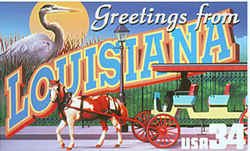

Louisiana Symbols
Louisiana History
Historic Facts & Overview of Louisiana History
Take a peek at Louisiana history. Discover an overview of Louisiana's rich history, heritage, historic events, and culture.
Situated in the Deep South, Louisiana, the "Pelican State," has a colorful history and was named in honor of King Louis XIV. A strong French influence is still evident throughout the state--its capital city is named Baton Rouge, French for "red stick," because the French-Canadian explorer Pierre Le Moyne d'Iberville visited the area in 1699 and observed a red cypress post. Today the city of New Orleans is known for its Mardi Gras and jazz festivals.
Overview of Louisiana History and Heritage
Louisiana has a rich, colorful historical background. The state has been governed under 10 different flags beginning in 1541 with Hernando de Soto's claim of the region for Spain. La Salle later claimed it for Bourbon France and over the years Louisiana was at one time or another subject to the Union Jack of Great Britain, the Tricolor of Napoleon, the Lone Star flag of the Republic of West Florida and the fifteen stars and stripes of the United States. At the outbreak of the Civil War, Louisiana became an independent republic for six weeks before joining the Confederacy.
In 1519 Alonso Alvarez de Pineda led an expedition along the northern
shore of the Gulf of Mexico and discovered the mouth of a great river
which may have been the Mississippi.
The Spanish adventurer Hernando de Soto died on the shores of the Mississippi
River near present-day Memphis while exploring the southeastern United
States. Each year the Mississippi, an Ojibwa Indian word meaning "big
river" carries 400,000,000 tons of sediment into the Gulf of Mexico
and discharges more water than all European rivers combined.
Authentic recorded history of this area doesn't actually begin until
1682. It was then that Sierra de La Salle, the French explorer, reached
the mouth of the Mississippi, claimed all its drainage basin for France,
and named the area Louisiana to honor Louis XIV.
Louis Juchereau de St. Denis founded Fort St. Jean Baptiste in 1714,
present-day Natchitoches, the first permanent settlement in Louisiana.
During the period from 1717 to 1731 Louisiana experienced a surge of
growth and development as a colony of the Company of the West and, after
1719, its successor the Company of the Indies. The Company of the West
was an elaborate colonization scheme of the Scotsman John Law, endorsed
by the French government, which wreaked havoc on the entire economy
of France.
Sieur de Bienville began building New Orleans as a company town for
the Company of the West in 1718 . By 1721 New Orleans had a population
of more than 370 people, including 147 male colonists, 65 female colonists,
38 children, 28 servants, 73 slaves and 21 Indians.
In 1792 France ceded to Spain the Louisiana region west of the Mississippi, along with the New Orleans area. The remaining land east of the river was ceded to Britain by the Treaty of Paris (1763). In 1800 Spain was forced by Napoleon Bonaparte to give back to France the Louisiana territory, including New Orleans. The United States acquired the area from France in 1803 through the Louisiana Purchase. In 1804 the region was divided into two sections- the District of Louisiana (later Missouri Territory), north of the 33rd parallel; and the Territory of Orleans, south of the parallel.
Earlier, in 1803, Louisiana had become a part of the United States because of the region's importance to the trade and security of the American mid-west. New Orleans and the surrounding territory controlled the mouth of the Mississippi River down which much of the produce of the mid-west traveled to reach market. To get the vital region in American hands, President Thomas Jefferson negotiated the Louisiana Purchase with Napoleon.
Soon after Louisiana became a state on April 30, 1812, war broke out with Great Britain. In 1812 the Territory of Orleans and a small part of West Florida, still claimed by Spain, were admitted to the Union as Louisiana, the 18th state. Spain ceded West Florida in 1821. In January 1815, the British attacked New Orleans, unaware that a peace treaty to end the War of 1812 had been signed two weeks earlier. They were defeated by Unites States forces under Andrew Jackson. The victory unified the Spaniards, French, Americans, and others who made up the population of the State.
With the acquisition of Louisiana, Jefferson nearly doubled the size of the fledgling US and made it a world power. Later, 13 states or parts of states were carved out of the Louisiana Purchase territory.
In 1849, Baton Rouge replaced New Orleans as the state capital. The capital was transferred in1850 to Baton Rouge from New Orleans where a new statehouse was waiting. Built at a cost of $100,000, the American gothic design of the building was very much in vogue. Mark Twain said about the building, "...this little sham castle ... this architectural falsehood ... this whitewashed castle with turrets and things would never been built in this otherwise honorable place had it not been for the medieval romances of Sir Walter Scott."
On Jan. 26, 1861, Louisiana seceded from the United States and joined the Confederacy a few months later. During the Civil War (1861-1865), over 56,000 soldiers fought in the Confederate Army from Louisiana.
For a year after the Civil War broke out Louisiana was undisturbed. Only three other states experienced more loss and destruction. In 1862, however, New Orleans was captured. In 1863 the longest siege in American military history took place at Port Hudson, the southernmost point of the Confederacy's hold on the Mississippi.
After the war Louisiana was readmitted to the Union in 1868, but forced to accept a new constitution giving rights to African-Americans." The Reconstruction Period" ended in 1877 in Louisiana when President Rutherford B. Hayes withdrew United States Army units from the state after the longest occupation of any of the southern states.
Through much of its early history Louisiana was a trading and financial center, and the fertility of its land made it one of the richest regions in America as first indigo then sugar and cotton rose to prominence in world markets. Many Louisiana planters were among the wealthiest men in America.
The plantation economy was shattered by the Civil War although the state continued to be a powerful agricultural region. The discovery of sulphur in 1869 and oil in 1901, coupled with the rise of forestry sent the state on a new wave of economic growth. Eventually, Louisiana became a major American producer of oil and natural gas and a center of petroleum refining and petrochemicals manufacturing, which it remains to this day.
World War II (1939-1945) helped the economy by bringing new industries
to Louisiana. Fuel, oil, and boats were required for the US Navy. Shipbuilding,
oil, and gas industries continued to grow during the 1950s. New factories
were built and shipping increased greatly at the Port of New Orleans.
Racial problems escalated during the end of the 1950s and 1960s. The
Louisiana State University became integrated in 1950. Segregation on
buses in New Orleans ended in 1958. Soon afterward, all schools, restaurants,
and state facilities were required to integrate. In 1977, Ernest N.
Morial became the first black mayor of New Orleans.
Industry in Louisiana continued to grow until the mid-1980s. Oil prices
fell, hurting both the oil and service industries. The aerospace industry
also slowed when the space shuttle Challenger exploded. Thousands lost
their jobs and unemployment in the state reached a national high.
Gambling was legalized in 1992, and new casinos have provided many Louisianans
with jobs. The tourism industry has also increased.
At the Present:
Agriculture: Louisiana is one of the nation's largest producers of
cotton, sugarcane, rice, sweet potatoes and pecans. The state is also
a major producer of soybeans and corn. The biggest land-based industry
in the state is forestry, with an economic impact from paper-making
and wood producers greater than all other crops combined. Poultry is
the largest livestock industry, followed by dairy and beef cattle. Louisiana
is also the nation's largest producer of alligator hides and crawfish.
(Source: Agriculture & Forestry Commissioner Bob Odom's Office)
Industry: In 1997, Louisiana's 4,562 manufacturing units employed 191,327
workers whose annual earnings totaled $7,046,381,641. Average weekly
wages in manufacturing increased by $44.69, or 6.6%, between 1996 and
second quarter 1998. Louisiana's overall employment and number of employees
reached record high levels in 1998. The rate of growth in total employment
in Louisiana in 1998 increased at twice the national rate of growth
of total employment. (Source: Secretary of Labor Garey Forster's Office)
Tourism: As Louisiana's second largest industry, tourism employed 110,000
people and generated $7.8 billion in revenue for 1998. The tourism industry
took immense pride in the state's historic places, unique arts and crafts,
natural re- sources and rich heritage as part of its efforts to accommodate
the 25.5 million visitors traveling to Louisiana last year. (Source:
Lt. Gov. Kathleen Blanco's Office)
Mineral Production: Principal mineral products are petroleum, natural
gas, salt (largest salt mine is in Louisiana), sulphur, carbon black
and gravel. Louisiana ranks second in the nation in oil production.






